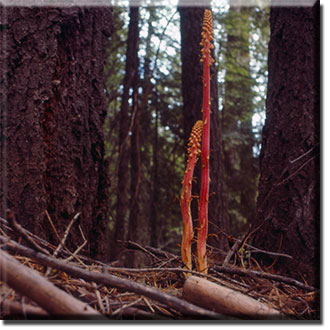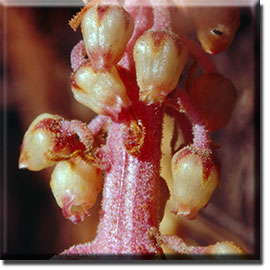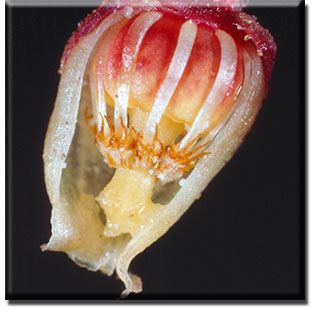Pterospora andromedea
The tallest of the monotropoids, or relatives of the Indian Pipe, is Pterospora andromedea, called Pinedrops. It can be more than a meter tall, so it is easily seen. The stems are rose to pink in color. Here are two stems still growing. Some plants of pinedrops on the floor of a pine forest. Pinedrops, Pterospora, grows in rich conifer forests from southern California to British Columbia, and east to Pennsylvania. It is probably the easiest to find of the monotropoids.
These unopened flowers of the Pinedrops are cream-colored and look somewhat like the resin droplets on a pine tree. Perhaps that gave the plant its name, or perhaps the name came from the sticky surfaces of the stems. Open flowers of Pterospora. The opening is very narrow, and the petal tips recurve. This urn-shaped flower is common in the heath family (Ericaceae). Bees are attracted to flowers with this shape. They cling to the flower by means of the recurved petal tips, and insert their long tongues into the flower to get the nectar reward. Here's what a bee would se as it approaches a flower of the Pinedrops. In the center of the opening is the sticky stigma, surrounded by 10 stamens. A bee's tongue can enter the flower, but the bee can't get its body inside the flower. Only a insect with a long tongue can reach the nectar reward.
A flower of Pterospora cut open to show the inner workings. This flower was just beginning to open. The stigma is sticky and receptive, but the anthers of the stamens aren't shedding pollen yet. Pollen that will fertilize this flower will have to come from a flower at a later stage. By shifting the time of receptivity of the stigma away from the time when the anthers in the same flower are shedding pollen, self-pollination can be avoided or lessened. This promotes more interbreeding among plants of a population. An older flower of Pterospora cut away to show the inside. Notice the narrow opening (the flower is shown pointing downwards, as it would be in nature). The anthers are brown, indicating that they have shed their pollen. There are a couple of very small brown hairs (awns) on each pair of anthers--these help position the anthers so that the pollen is shed in precisely the right location for a bee to pick it up. 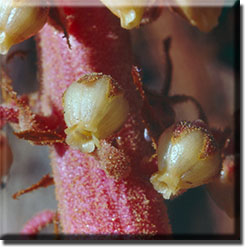 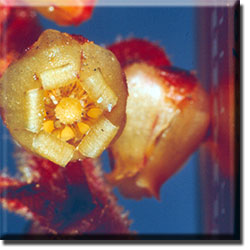 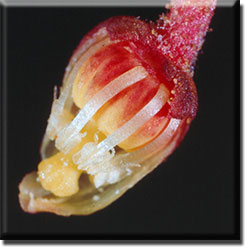
The fruits of Pterospora are brown and dry at maturity. The seeds escape through slits in the sides of the fruits.
The seeds of Pterospora are very small. Each seed consists of two parts: the embryo is contained within the brownish round structure, and attached to that is a transparent triangular wing. The wing permits the seeds to sail long distances on a windy day. This in part accounts for the very wide geographical distribution of the Pinedrops plant. The name "Pterospora" means "Wing-seed" in Greek.  |
